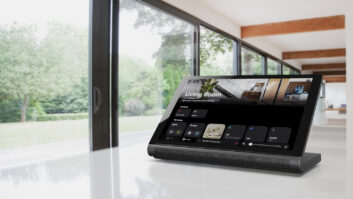One of FIBARO’s first products was its “cat’s eye” motion sensor.

There was a time when most devices for the home looked homogenous. Product manufacturers, quite literally, did not think outside the box: a square or rectangular box. (Or in the case of the older thermostats, a plain brass circle.) But times are changing, particularly in the world of connected devices and the “smart home.”
Driven by Demand
Design is increasingly becoming a major consideration, as manufacturers realize that their customers want products that reflect or complement a homeowner’s individual taste and a home’s design aesthetics. End users want products that either look really sleek and cool, or are small enough to not stand out like a sore thumb (or box). They also want a lot of functionality to fit into that unobtrusive footprint.
Increasingly, architects and interior designers are affecting the growth of creativity in device design. The people who often specify the products that go into a new home (or new home purchase) want devices that they might put into their own homes. As the connected home becomes more prevalent, the number of sensors and devices in a home grows. A recent report on the connected home by research firm BI Intelligence estimates that connected-home device shipments will grow at a compound annual rate of 67 percent over the next five years.
Even when their customers want all the latest functionality and multiple connected devices, architects and designers want the space to be beautiful and uncluttered; they don’t want the walls cluttered with unsightly bumps or a tangle of wires.
In fact, the idea of wireless home automation was created in large part as a response to the need for simple installation without cutting holes in walls and desired for improved aesthetics in the home.
Design with a Purpose
When a company is working toward creating a smart home product that looks like nothing else on the market—one that features an innovative, eye-pleasing design—it is essential to begin the design process with the reason for the product’s existence in the first place. In fact, connected devices are defined by noted product designer, Ian Bach, as “purpose-specific physical products that exist as part of a digital service ecosystem.” Bach goes on to say in his blog titled, Designing Connected Products, “Start agnostic of any design outputs. Sure, we’ve got an expanded palette that includes physical devices, but first we need to ask what value we’re looking to offer to the user, without getting bogged down by any preconceived notions of what we need to build.”
Even my company, FIBARO, good design is produced with a purpose. For example, one of our first “plug and play” products was the Flood Sensor. FIBARO product engineers began the process of product creation by taking a look at the functionality of existing water-sensing devices, and the problems that some customers were having with these devices. There were issues of corrosion (a natural problem under the sink and in other wet areas), problems of balance or making contact with the surface (some early water sensors only had two prongs), problems with delayed notification (finding out too late that the device had been moved, or kicked), and limited functionality.
The engineers and designers worked together to solve the problems inherent in earlier devices and take the device to previously unexplored places. Actually FIBARO’s engineering and manufacturing departments are all in the same building, so it is a lot easier for teams to walk down the hall to work together on the countless iterations that take place to get to a final product.
This isn’t always the case at some other companies, where conceptual designs are sent to a manufacturing facility in another country. This can lead to production delays, communication failures and cost overruns.
Three Feet, One Small Footprint
Working together, FIBARO designers and engineers start by giving the product a rough size and shape in the form of 2D and 3D renderings. In the case of the Flood Sensor, designers fashioned the product casing in the shape of a water droplet, and specified a high gloss, durable plastic casing material that is pleasing from both a visual and tactile perspective, yet durable if dropped and resistant to damage.
They also gave the Flood Sensor three gold telescoping legs so that the three feet maintain solid contact with the ground even on uneven surfaces, while never corroding. Both crucial elements for a sensor you put your trust in. Meanwhile, the hardware engineers were tasked with fitting abundant functionality and advanced technology into this compact product.
The Flood Sensor functionality includes a built-in temperature sensor, a built-in tilt sensor for tampering or notification of being moved, a Z-wave network range tester to ensure that the product is in constant communication with the hub and other devices. Additionally they made it compatible with standard alarm systems for further integration options.
A plug for the little guy. As more features are added to smart home devices, the mission to maintain that small footprint becomes a growing challenge. For example, making an old-fashioned small wall plug is easy. Making an intelligent, remotely controlled, energy monitoring wall plug that is also extremely compact is difficult.
The European version of the FIBARO Wall Plug has the same shape and circumference of European sockets. Previous iterations of smart plugs were oversized and stuck out from European wall plates. The FIBARO Wall Plug, the smallest smart plug in the world, was designed to be attractive, unobtrusive and extremely functional. In addition to its small size, the design calling card of the FIBARO Wall Plug is its crystal RGB LED ring that changes color to inform the user of the current load of the connected appliance. This same attention to design, functionality and detail is coming to the U.S. version of the wall plug.
A Swipe at typical devices. Sometimes smart home devices can be designed to go largely unnoticed, to blend in with an environment. Sometimes devices can be designed to, in certain applications, not be visible at all. This is the case with FIBARO’S forthcoming gesture control pad that they are calling The Swipe.
This is another example of a product design that began with a unique purpose. A hospital came to FIBARO looking for a no-touch switch, one that couldn’t transfer bacteria. Inspired by this idea, the company decided to work on a similar product for the average consumer.
Currently being finalized and arriving soon, the Swipe is a wireless control pad that incorporates gesture sensors. It can be mounted on a wall, behind a wall, or even under a counter so users can control home devices like roller shades, light switches and audio-video equipment without touching or even seeing the device.
The beauty of home control. Even back in the mid-20th century, there were products that delivered home control: thermostats that made homes more comfortable; alarm panels and motion sensors that made home safer; and a handful of other devices. Consumers didn’t care that much about what these devices looked like.
But now, as homes become “smarter” and everything from refrigerators to tooth brushes to water sensors become automated and connected, homes can become filled with electronic devices. To ensure that homes stay beautiful, comfortable and inviting, it’s essential that we continue to redefine what smart devices look like, so that we never sacrifice beauty, style and personal taste for the security and convenience of the automated home.







